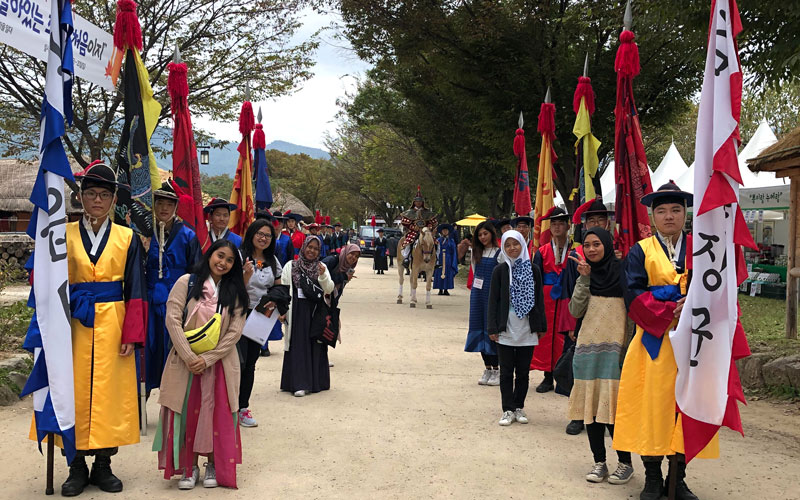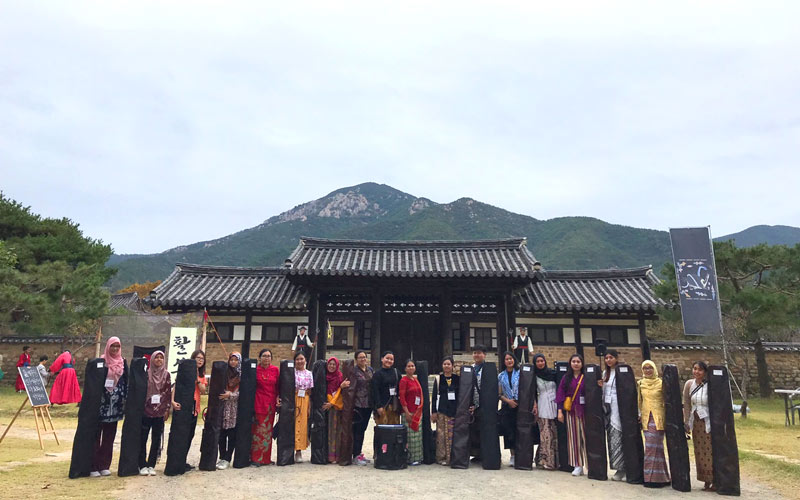- 한국어
- English
- 日本語
- 中文
- العربية
- Español
- Français
- Deutsch
- Pусский
- Tiếng Việt
- Indonesian
By Honorary Reporter Jeanne O and Fitri Amalia from Indonesia
Photos = Jeanne O and Fitri Amalia

The annual Naganeupseong Folk Culture Festival from Oct. 18-20 was held in Suncheon, Jeollanam-do Province, under the theme "Come on! It’s your first experience living during the Joseon Dynasty era, right?"
Performances of traditional Korean arts were presented on the main stage of the festival including pansori (solo lyrical opera), jultagi (tightrope walking), baekjungnori (folk play) and a horseback parade. Visitors could also go inside a Hanok (traditional Korean home).
This year's festival saw a major surprise as performers were not only from Korea but also Indonesia.
Living museum
Surrounded by mountains, Korea's Naganeupseong Folk Village is a well-preserved traditional village in Suncheon. As the lone remaining Joseon-era fortress in Jeollanam-do, this village retains traditional Joseon culture as well as nine thatched-roof houses with unique clay rooms. The Jeollanam-do-style homes have been preserved as they were in their original state 600 years ago. With about 90 resident families, the village in 1983 was designated Historical Site No. 302 by the Korean government and a World Heritage Site by UNESCO in 2011.
The village also appeared in the famous Korean drama "Dae Jang Geum (Jewel in the Palace)." Visitors can learn about pansori and the gayageum (zither), and also make the rice wine makgeolli and the rice cake injeolmi.

An Indonesian troupe specializing in gayageum byeongchang, a traditional musical genre in which a performer simultaneously sings and plays the zither, performed on the main stage during the first two days of the festival. The 18-member group, which played at the Korean Cultural Center in Jakarta, flew from the Indonesian capital to Korea just to perform at this festival. For certain members of the group, it was their first visit to Korea.
Over two days, they performed traditional Korean songs such as "Danga Honamga" and popular folk songs like "Gaetaryeong," "Ganggangsullae" and "Jindo Arirang." They also sang "Ampar Ampar Pisang," a folk song from the Indonesian province of South Kalimantan. The audience cheered the impressive performance, with the emcee saying, "Eighteen Indonesians just sang our folk songs in fluent Korean, how surprising is that?" Certain audience members and Suncheon residents even went backstage to express their appreciation to the group, with a senior village resident saying, "It was a great performance. Thanks for visiting our village."
Troupe member Rizky Fauzia said, "I found the festival very interesting because I really like traditional Korean music and everything about Korean culture. As an Indonesian and someone who performed in the festival, I was happy to join because I now have more experience in and improved my knowledge of Korean culture, and also of the people who love their culture."
Fauzia added that she learned to play other traditional Korean instruments such as the sogeum (bamboo transverse flute), danso (vertical bamboo flute) and janggu (hourglass-shaped drum).
Fellow troupe member Rakai Mada Kertosuryo said, "This kind of festival is very important to promote traditional Korean culture to foreigners and re-educate Korean youths about their country's history and culture. I was very excited to get involved in this festival as a guest, the staff was very kind and the food they served was delicious."
Rakai also recommended putting Naganeupsong Folk Village on every bucket list for travel in Korea.
chaey0726@korea.kr
*This article is written by a Korea.net Honorary Reporter. Our group of Honorary Reporters are from all around the world, and they share with Korea.net their love and passion for all things Korean.